Mahatma Gandhi
The Wilderness
Before people formed cities they and the animals on the earth deposited their urine and feces on the ground here and there. Whether on the ground or shallow buried the microscopic creatures in the earth would convert it all back to useful food for growing plants.
From the animal deposits the soil received the macro and micro nutrients. This cycle kept the macro nutrients locked in the cycles of the land and kept the lakes, rivers, and oceans clean, or nutrient poor. The systems were ecologically diverse and balanced. This remained so until the human population reached a level having large cities.
Urban Life
With the beginnings of cities and civilization there come to be two divergent points of view about manures, especially human manure. One point of view is that all manure is a valuable commodity. The other point of view is that it is a “waste product” to get rid of.
The Outhouse
There were two kinds of outhouses. There is the out house of areas of Asia that were designed to capture and hold the deposits and there were outhouses designed to place the deposits out of sight -- buried.
Out houses designed to bury the “waste” might pollute the ground water with a plume extending down into the ground 25 feet or more.
The outhouse remained the “system” of preference for thousands of years and was replaced when running water was piped to peoples houses.
The EPA says that a density of more than forty septic systems per square mile creates a high probability of subsurface contamination.
In urban areas outhouses were replaced with cesspools. These stone lined holes in the ground were designed to receive the contents of chamber pots.
Running Water
Running water was a feature of a few older civilizations. It is evident in Machu Pichu and in the Roman empire in 500 BC.
In our current era, piped in water began in America early in the 19th century. In 1802 the first waterworks was installed in Philadelphia. By 1860 the number of waterworks was 136, by 1880 there were nearly 600. Having a water supply created water fixtures such as baths, kitchen sinks, and flush toilets. It also increased the per capita usage of water per person from 3 to 5 gallons per day to as much as 100.
Water piped into the home required that it be piped out after use. The first means of piping the water out was the cesspool.
The Cesspool
With running water came the water closet, flush toilets. The effect of running water was to overwhelm the cesspools resulting in overflows of fecally polluted water along with awful smells and water-borne diseases. Historically the introduction of running water into a community would result in epidemics of diseases such as cholera. In Paris in 1832 20,000 people died of cholera.
Before running water some of the humanure was removed by “scavengers” and returned to the soil in agriculture. With running water the practice of removing the contents of cesspools back to the land came to a halt.
Cities had sewers prior to running water. They were mostly trenches in the roads that were sometimes covered and sometimes not. These sewers were used for rain water and normal city dirt. Known as storm sewers, they only moved along when rains came.
With running water and overwhelmed cesspools it became common for people to break the law and place these “wastes” and other wastes into the sewers.
The Sewers
With all these problems came the “solution” of closed pipe sewer systems. These systems would take the sewage away from the homes and away from the cities. To keep such a system moving a large quantity of water was needed in the pipes.
The water-carriage system of sewerage introduced a new set of problems and, about these problems, a new set of debates among sanitary engineers in Europe and the United States. The engineers were divided again between those who believed in the value of human excreta to agriculture and those who did not. The believers argued in favor of “sewage farming,” the practice of irrigating neighboring farms with municipal sewage. The second group, arguing that “running water purifies itself” (the more current slogan among sanitary engineers: “the solution to pollution is dilution”), argued for piping sewage into lakes, rivers, and oceans. In the United States, the engineers who argued for direct disposal into water had, by the turn of the 19th century, won this debate. By 1909, untold miles of rivers had been turned functionally into open sewers, and 25,000 miles of sewer pipes had been laid to take the sewage to those rivers (Tarr and Dupuy 1988).
In cities with sewers the cholera epidemics were eliminated. Downstream from those cities other cities and towns found themselves having typhoid deaths due to the polluted water in the rivers.
The next logical step was the treatment of sewage before it was put into the river. That change ended the typhoid problems.
The rapid creation of large sewers throughout the country was partly the through the support of industries. Industries saw the sewers as the simple and cheap way to get rid of industrial wastes. The public paid for the sewers in tax dollars and the industries benefited.
By the middle of the 20th century it became apparent to the public that the industrial waste in the sewers was causing major problems. The rivers, lakes, streams, and oceans were becoming filthy and toxic. This then led to the treatment phase.
Treatment
The first step is called primary treatment. This is a simple process of screening the sewage and allowing it to settle. All the nutrients and chemicals remain in the water.
The next step is called secondary treatment. In this step there is some biological stabilization through forced aeration and chemical flocculation and precipitation of some phosphates. In spite of these processes the efffluent reaching the bodies of water are still rich in nitrates and phosphates. Nitrates and phosphates are fertilizer and cause the growth of algae which causes water to die of eutrophication as oxygen is pulled from the water.
In the secondary treatment process industrial toxins and heavy metals are not removed.
The third step is called tertiary treatment. It is expensive and does not fully remove some nitrates, heavy metals, and toxic chemicals.
A by-product of treatment produces a substance called sludge. It consists of the waste materials coming from industry and homes. The chemical composition of the sludge is dependent on what comes to the treatment plant. If there were no chemicals, no toxins, and no heavy metals that sludge would pose no risk if used as a fertilizer for agriculture.
There are the heavy metals which, though they are micro-nutrients crucially needed in tiny amounts for growth of life, are toxic to life when they cross the threshold firmly established in the cells of life. There are organochlorine estrogen mimickers, the best known of which are DDT, chlordane, alpha-hexachlorocyclohexane, 2,4,D, PCBs, and dioxin. There are halogenated aliphatic (chain) hydrocarbons, aromatic (ring) hydrocarbons, chloro- and nitro-aromatic hydrocarbons, phthalates, halogenated ethers, and phenols. There is radioactive matter from hospitals. All of these are destructive of life processes (Reutergårdh 1966).
Septic Systems
Septic systems are a type of On-Site Sewage Facility (OSSF). In North America, approximately 25% of the population relies on septic tanks; this can include suburbs and small towns as well as rural areas (Indianapolis is an example of a large city where many of the city’s neighborhoods are still on separate septic systems). In Europe, they are in general limited to rural areas only. Since a septic system requires a drainfield that uses a lot of land area, they are not suitable for densely built cities.
The term “septic” refers to the anaerobic bacterial environment that develops in the tank which decomposes or mineralizes the waste discharged into the tank. Septic tanks can be coupled with other onsite wastewater treatment units such as biofilters or aerobic systems involving artificial forced aeration.
Periodic preventive maintenance is required to remove the irreducible solids that settle and gradually fill the tank, reducing its efficiency. In most jurisdictions this maintenance is required by law, yet often not enforced. Those who ignore the requirement will eventually be faced with extremely costly repairs when solids escape the tank and destroy the clarified liquid effluent disposal means. A properly maintained system, on the other hand, can last for decades or possibly even a lifetime.[wikipedia]
Proper maintenance of a septic tank means the periodic removal of the solids and liquid in the tank. The removed solids and liquids are called septage. Over the decades many method of dealing with the septage have been tried. In the past it could be dumped or sprayed directly on the land. In current times it is either taken to the nearest sewage plant or to a specialized processer such as Biorecycling.
Constructed or Artificial Wetlands System
An artificial wetlands system diverts wastewater through an aquatic environment consisting of aquatic plants such as water hyacinths, bullrushes, duckweed, lilies and cattails. The plants act as marsh filters, and the microbes which thrive on their roots break down nitrogen and phosphorous compounds, as well as toxic chemicals. They don’t break down heavy metals.
This technology shows potential as a cost-effective alternative to wastewater treatment. The treatment efficiency of properly constructed wetlands is said to compare well with conventional treatment systems.
Unfortunately these systems do not recover the agricultural resources available in humanure.
Composting Systems
Composting is the bio-chemical decomposition of organic matter by aerobic organisms, i.e., organisms which get oxygen from the atmosphere and give off carbon dioxide. Composting takes place in all soils which support plant and animal life. The compost toilet employs the same process in the controlled environment of the compost chamber.
This process is distinct from anaerobic decomposition, which takes place naturally in water-saturated environments such as swamps, and is typical of septic tanks. Anaerobic, or liquid-saturated, conditions produce methane and the offensive odors associated with septic systems.
Organisms found in the composter include bacteria, actinomycetes, fungi, arthropods, and earthworms and are added manually once the system is operating. Energy, carbon dioxide and water vapor are released by the organic matter in feces through the activity of the composting organisms. A less chemically complex, more chemically stable substance, rich in organic matter, is produced. Feces volume, which is mostly water, is reduced by over 90%.
There are two methods for composting humanure, slowly as in a composting toilet and through thermophilic composting.
Composting Toilets
Temperatures in the compost toilet remain in the middle, or mesophilic, range (65-113°F) and don’t exceed 100°. Potential pathogens in feces are, therefore, not destroyed by heat. Those pathogens that require an aqueous environment die quickly in the non-saturated condition of the compost chamber. Others die because of the intense competition for nutrients; still others are consumed by predators which populate the system. The biological content of the dry end-product is similar to that found in topsoil. This method produces a soil additive safe for landscaping, horticultural, or orchard use.
Thermophilic Composting
This method cultivates heat-loving or thermohpilic microorganisms in the composting process. These bacteria and fungi can create an environment in the compost which destroys disease organisms that can exist in humanure. This product is safe for food cultivation.

A Bear in the Woods
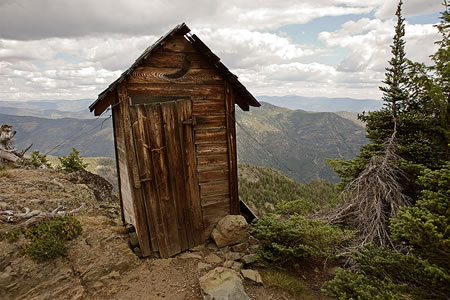
Outhouse

Roman Aqueduets
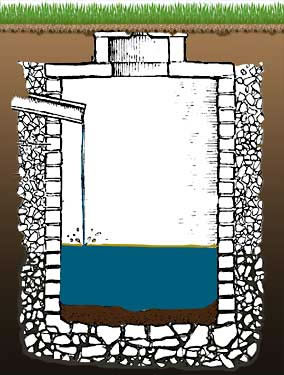
Cesspool Design
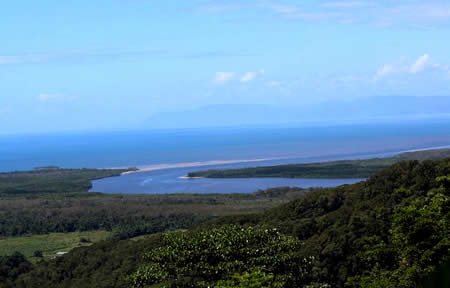
A River entering the Ocean

A Paris Sewer

Primary Treatment
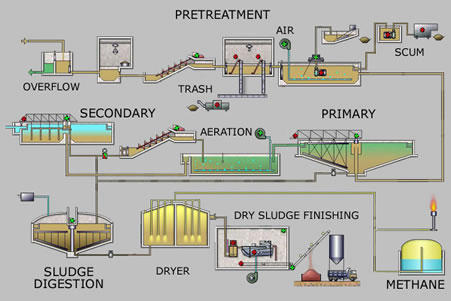
Sewage Treatment Diagram

Septic System

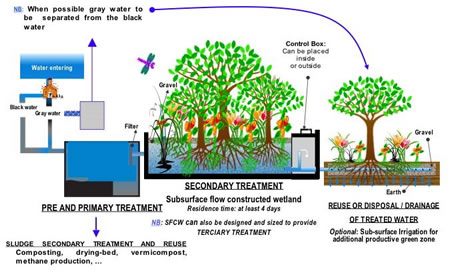
Artificial Wetlands

Compost
